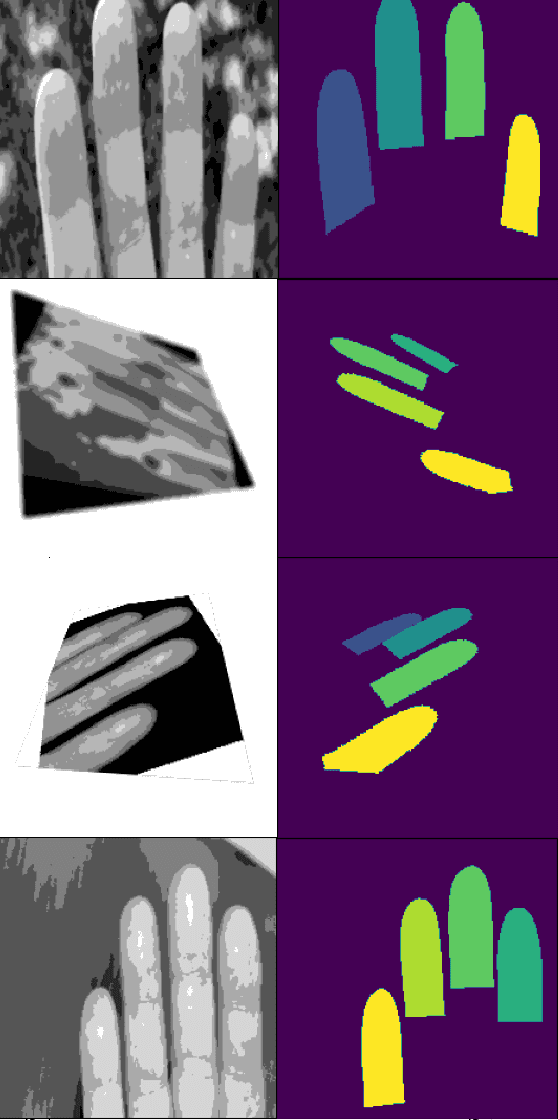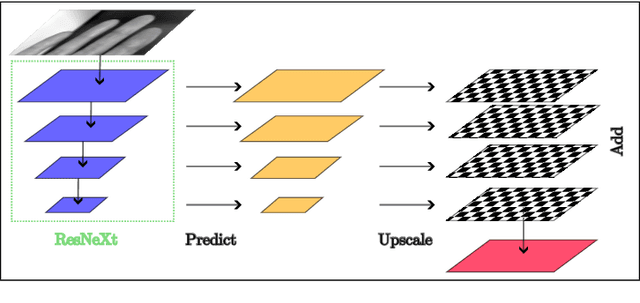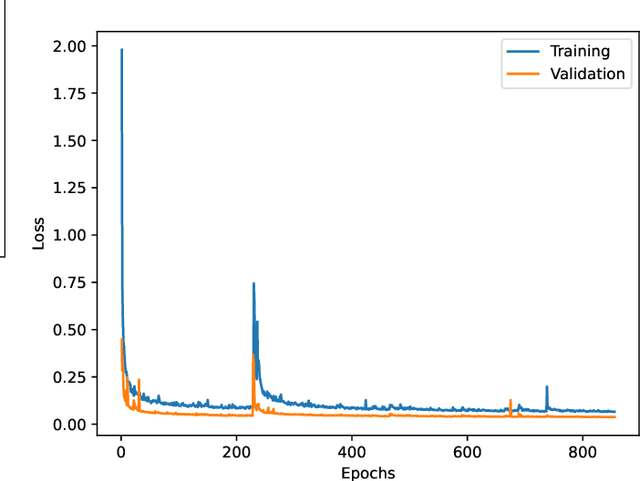Hand Segmentation
Hand segmentation is the process of identifying and segmenting a person's hand in images or videos.
Papers and Code
Beyond-Labels: Advancing Open-Vocabulary Segmentation With Vision-Language Models
Jan 29, 2025Self-supervised learning can resolve numerous image or linguistic processing problems when effectively trained. This study investigated simple yet efficient methods for adaping previously learned foundation models for open-vocabulary semantic segmentation tasks. Our research proposed "Beyond-Labels," a lightweight transformer-based fusion module that uses a handful of image segmentation data to fuse frozen image representations with language concepts. Furthermore, we efficiently captured positional information in images using Fourier embeddings, thus improving the generalization across various image sizes. Extensive ablation tests were performed to investigate the important components of our proposed method; when tested against the common benchmark PASCAL-5i, it demonstrated superior performance despite being trained on frozen image and language characteristics.
Testing Human-Hand Segmentation on In-Distribution and Out-of-Distribution Data in Human-Robot Interactions Using a Deep Ensemble Model
Jan 13, 2025



Reliable detection and segmentation of human hands are critical for enhancing safety and facilitating advanced interactions in human-robot collaboration. Current research predominantly evaluates hand segmentation under in-distribution (ID) data, which reflects the training data of deep learning (DL) models. However, this approach fails to address out-of-distribution (OOD) scenarios that often arise in real-world human-robot interactions. In this study, we present a novel approach by evaluating the performance of pre-trained DL models under both ID data and more challenging OOD scenarios. To mimic realistic industrial scenarios, we designed a diverse dataset featuring simple and cluttered backgrounds with industrial tools, varying numbers of hands (0 to 4), and hands with and without gloves. For OOD scenarios, we incorporated unique and rare conditions such as finger-crossing gestures and motion blur from fast-moving hands, addressing both epistemic and aleatoric uncertainties. To ensure multiple point of views (PoVs), we utilized both egocentric cameras, mounted on the operator's head, and static cameras to capture RGB images of human-robot interactions. This approach allowed us to account for multiple camera perspectives while also evaluating the performance of models trained on existing egocentric datasets as well as static-camera datasets. For segmentation, we used a deep ensemble model composed of UNet and RefineNet as base learners. Performance evaluation was conducted using segmentation metrics and uncertainty quantification via predictive entropy. Results revealed that models trained on industrial datasets outperformed those trained on non-industrial datasets, highlighting the importance of context-specific training. Although all models struggled with OOD scenarios, those trained on industrial datasets demonstrated significantly better generalization.
Boosting Sclera Segmentation through Semi-supervised Learning with Fewer Labels
Jan 13, 2025Sclera segmentation is crucial for developing automatic eye-related medical computer-aided diagnostic systems, as well as for personal identification and verification, because the sclera contains distinct personal features. Deep learning-based sclera segmentation has achieved significant success compared to traditional methods that rely on hand-crafted features, primarily because it can autonomously extract critical output-related features without the need to consider potential physical constraints. However, achieving accurate sclera segmentation using these methods is challenging due to the scarcity of high-quality, fully labeled datasets, which depend on costly, labor-intensive medical acquisition and expertise. To address this challenge, this paper introduces a novel sclera segmentation framework that excels with limited labeled samples. Specifically, we employ a semi-supervised learning method that integrates domain-specific improvements and image-based spatial transformations to enhance segmentation performance. Additionally, we have developed a real-world eye diagnosis dataset to enrich the evaluation process. Extensive experiments on our dataset and two additional public datasets demonstrate the effectiveness and superiority of our proposed method, especially with significantly fewer labeled samples.
Static Segmentation by Tracking: A Frustratingly Label-Efficient Approach to Fine-Grained Segmentation
Jan 12, 2025We study image segmentation in the biological domain, particularly trait and part segmentation from specimen images (e.g., butterfly wing stripes or beetle body parts). This is a crucial, fine-grained task that aids in understanding the biology of organisms. The conventional approach involves hand-labeling masks, often for hundreds of images per species, and training a segmentation model to generalize these labels to other images, which can be exceedingly laborious. We present a label-efficient method named Static Segmentation by Tracking (SST). SST is built upon the insight: while specimens of the same species have inherent variations, the traits and parts we aim to segment show up consistently. This motivates us to concatenate specimen images into a ``pseudo-video'' and reframe trait and part segmentation as a tracking problem. Concretely, SST generates masks for unlabeled images by propagating annotated or predicted masks from the ``pseudo-preceding'' images. Powered by Segment Anything Model 2 (SAM~2) initially developed for video segmentation, we show that SST can achieve high-quality trait and part segmentation with merely one labeled image per species -- a breakthrough for analyzing specimen images. We further develop a cycle-consistent loss to fine-tune the model, again using one labeled image. Additionally, we highlight the broader potential of SST, including one-shot instance segmentation on images taken in the wild and trait-based image retrieval.
TipSegNet: Fingertip Segmentation in Contactless Fingerprint Imaging
Jan 09, 2025



Contactless fingerprint recognition systems offer a hygienic, user-friendly, and efficient alternative to traditional contact-based methods. However, their accuracy heavily relies on precise fingertip detection and segmentation, particularly under challenging background conditions. This paper introduces TipSegNet, a novel deep learning model that achieves state-of-the-art performance in segmenting fingertips directly from grayscale hand images. TipSegNet leverages a ResNeXt-101 backbone for robust feature extraction, combined with a Feature Pyramid Network (FPN) for multi-scale representation, enabling accurate segmentation across varying finger poses and image qualities. Furthermore, we employ an extensive data augmentation strategy to enhance the model's generalizability and robustness. TipSegNet outperforms existing methods, achieving a mean Intersection over Union (mIoU) of 0.987 and an accuracy of 0.999, representing a significant advancement in contactless fingerprint segmentation. This enhanced accuracy has the potential to substantially improve the reliability and effectiveness of contactless biometric systems in real-world applications.
UNIR-Net: A Novel Approach for Restoring Underwater Images with Non-Uniform Illumination Using Synthetic Data
Jan 15, 2025Enhancing underwater images with non-uniform illumination (NUI) is crucial for improving visibility and visual quality in marine environments, where image degradation is caused by significant absorption and scattering effects. However, traditional model-based methods are often ineffective at capturing the complex illumination variations present in such images, resulting in limited visual improvements. On the other hand, learning-based approaches have shown promising results but face challenges due to the lack of specific datasets designed to effectively address the non-uniform illumination problem. To overcome these challenges, the Underwater Non-uniform Illumination Restoration Network (UNIR-Net) is introduced, a novel method that integrates illumination enhancement and attention blocks, along with visual refinement and contrast correction modules. This approach is specifically designed to mitigate the scattering and absorption effects that cause light attenuation in underwater environments. Additionally, the Paired Underwater Non-uniform Illumination (PUNI) dataset is presented, a paired resource that facilitates the restoration of underwater images under non-uniform illumination conditions. Extensive experiments conducted on the PUNI dataset and the large-scale real-world Non-Uniform Illumination Dataset (NUID), which contains underwater images with non-uniform illumination, demonstrate the robust generalization ability of UNIR-Net. This method outperforms existing approaches in both quantitative metrics and qualitative evaluations. Furthermore, UNIR-Net not only significantly enhances the visual quality of images but also improves performance in advanced computer vision tasks, such as semantic segmentation in underwater environments, highlighting its broad applicability and potential impact. The code of this method is available at https://github.com/xingyumex/UNIR-Net
Swin-X2S: Reconstructing 3D Shape from 2D Biplanar X-ray with Swin Transformers
Jan 10, 2025The conversion from 2D X-ray to 3D shape holds significant potential for improving diagnostic efficiency and safety. However, existing reconstruction methods often rely on hand-crafted features, manual intervention, and prior knowledge, resulting in unstable shape errors and additional processing costs. In this paper, we introduce Swin-X2S, an end-to-end deep learning method for directly reconstructing 3D segmentation and labeling from 2D biplanar orthogonal X-ray images. Swin-X2S employs an encoder-decoder architecture: the encoder leverages 2D Swin Transformer for X-ray information extraction, while the decoder employs 3D convolution with cross-attention to integrate structural features from orthogonal views. A dimension-expanding module is introduced to bridge the encoder and decoder, ensuring a smooth conversion from 2D pixels to 3D voxels. We evaluate proposed method through extensive qualitative and quantitative experiments across nine publicly available datasets covering four anatomies (femur, hip, spine, and rib), with a total of 54 categories. Significant improvements over previous methods have been observed not only in the segmentation and labeling metrics but also in the clinically relevant parameters that are of primary concern in practical applications, which demonstrates the promise of Swin-X2S to provide an effective option for anatomical shape reconstruction in clinical scenarios. Code implementation is available at: \url{https://github.com/liukuan5625/Swin-X2S}.
Hyperbolic Binary Neural Network
Jan 07, 2025



Binary Neural Network (BNN) converts full-precision weights and activations into their extreme 1-bit counterparts, making it particularly suitable for deployment on lightweight mobile devices. While binary neural networks are typically formulated as a constrained optimization problem and optimized in the binarized space, general neural networks are formulated as an unconstrained optimization problem and optimized in the continuous space. This paper introduces the Hyperbolic Binary Neural Network (HBNN) by leveraging the framework of hyperbolic geometry to optimize the constrained problem. Specifically, we transform the constrained problem in hyperbolic space into an unconstrained one in Euclidean space using the Riemannian exponential map. On the other hand, we also propose the Exponential Parametrization Cluster (EPC) method, which, compared to the Riemannian exponential map, shrinks the segment domain based on a diffeomorphism. This approach increases the probability of weight flips, thereby maximizing the information gain in BNNs. Experimental results on CIFAR10, CIFAR100, and ImageNet classification datasets with VGGsmall, ResNet18, and ResNet34 models illustrate the superior performance of our HBNN over state-of-the-art methods.
HAND: Hierarchical Attention Network for Multi-Scale Handwritten Document Recognition and Layout Analysis
Dec 25, 2024Handwritten document recognition (HDR) is one of the most challenging tasks in the field of computer vision, due to the various writing styles and complex layouts inherent in handwritten texts. Traditionally, this problem has been approached as two separate tasks, handwritten text recognition and layout analysis, and struggled to integrate the two processes effectively. This paper introduces HAND (Hierarchical Attention Network for Multi-Scale Document), a novel end-to-end and segmentation-free architecture for simultaneous text recognition and layout analysis tasks. Our model's key components include an advanced convolutional encoder integrating Gated Depth-wise Separable and Octave Convolutions for robust feature extraction, a Multi-Scale Adaptive Processing (MSAP) framework that dynamically adjusts to document complexity and a hierarchical attention decoder with memory-augmented and sparse attention mechanisms. These components enable our model to scale effectively from single-line to triple-column pages while maintaining computational efficiency. Additionally, HAND adopts curriculum learning across five complexity levels. To improve the recognition accuracy of complex ancient manuscripts, we fine-tune and integrate a Domain-Adaptive Pre-trained mT5 model for post-processing refinement. Extensive evaluations on the READ 2016 dataset demonstrate the superior performance of HAND, achieving up to 59.8% reduction in CER for line-level recognition and 31.2% for page-level recognition compared to state-of-the-art methods. The model also maintains a compact size of 5.60M parameters while establishing new benchmarks in both text recognition and layout analysis. Source code and pre-trained models are available at : https://github.com/MHHamdan/HAND.
Switch-a-View: Few-Shot View Selection Learned from Edited Videos
Dec 24, 2024We introduce Switch-a-View, a model that learns to automatically select the viewpoint to display at each timepoint when creating a how-to video. The key insight of our approach is how to train such a model from unlabeled--but human-edited--video samples. We pose a pretext task that pseudo-labels segments in the training videos for their primary viewpoint (egocentric or exocentric), and then discovers the patterns between those view-switch moments on the one hand and the visual and spoken content in the how-to video on the other hand. Armed with this predictor, our model then takes an unseen multi-view video as input and orchestrates which viewpoint should be displayed when. We further introduce a few-shot training setting that permits steering the model towards a new data domain. We demonstrate our idea on a variety of real-world video from HowTo100M and Ego-Exo4D and rigorously validate its advantages.
 Add to Chrome
Add to Chrome Add to Firefox
Add to Firefox Add to Edge
Add to Edge